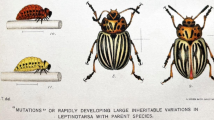Abstract.
A population, reproducing wholly by selfing, is assumed to be observed at times \({{0,1,\ldots}}\). Individuals between x−1 and x units of age at time t are said to be in age class x at that time. The rate of increase in the long run of individuals of type A iA j is denoted by m ij +1=m ji +1. For each genotype there is also a set of reproductive values, corresponding to all age classes and genotypes of individuals having descendants of that genotype. Then, if the number of individuals of each sort of ancestor is multiplied by its reproductive value and the products are summed, the result is the total value, which is V ij (t) for genotype A iA j . Then V ij (t+1)−V ij (t) is equal to m ij V ij (t), where m ij is the Malthusian parameter for A iA j . Furthermore, if the mean and variance at time t of the m ij ‘s, weighted by their corresponding reproductive values, are respectively (t) and Σ m 2(t), then m¯(t+1)−m¯(t)=Σ m 2(t)/(1+m¯(t)).
Similar content being viewed by others
References
Charlesworth, B.: Evolution in Age-Structured Populations. Cambridge University Press, second edition, 1994
Crow, J.F.: Gene frequency and fitness change in an age-structured population. Ann. Hum. Gen. 24, 335–370 (1978)
Crow, J.F.: Perspective: Here’s to Fisher, additive genetic variance, and the Fundamental theorem of natural selection. Evolution 56, 1313–1316 (2002)
Denniston, C.: An incorrect definition of fitness revisited. Ann. Hum. Genet. London 42, 77–85 (1978)
Edwards, A.W.F.: The fundamental theorem of natural selection. Biol. Rev. 69, 443–474 (1994)
Edwards, A.W.F.: Foundations of Mathematical Genetics. Cambridge University Press, second edition, 2000
Ewens, W.J.: An interpretation and proof of the fundamental theorem of natural selection. Theor. Population Biol. 36, 167–180 (1989)
Fisher, R.A.: The actuarial treatment of official birth records. Eugen. Rev. 19, 103–108 (1927)
Fisher, R.A.: The Genetical Theory of Natural Selection. Clarenden Press, Oxford, 1930
Fisher, R.A.: The Genetical Theory of Natural Selection. Second edition, Dover Publications, Inc., New York, 1958
Fisher, R.A.: The Genetical Theory of Natural Selection. Complete Variorum Edition. Edited with a foreward and notes by J.H. Bennett, Oxford University Press, 1999
Goodman, L.A.: On the reconciliation of mathematical theories of population growth. J. Roy. Statist. Soc. A 130, 541–553 (1967)
Karlin, S. and Lessard, S.: Theoretical Studies on Sex Ratio Evolution. Princeton University Press. Princeton, New Jersey, 1986
Kempthorne, O.: An Introduction to Genetic Statistics. John Wiley & Sons, Inc., New York, 1957
Kimura, M. and Ohta, T.: Theoretical Aspects of Population Genetics. Princeton University Press, Princeton, New Jersey, 1971
Leslie, P.H.: On the use of matrices in certain population mathematics. Biometrika 33, 183–212 (1945)
Leslie, P.H.: Some further notes on the use of matrices in population mathematics. Biometrika 35, 213–245 (1948)
Lessard, S.: Fisher’s fundamental theorem of natural selection revisited. Theor. Population Biol. 52, 119–136 (1997)
Lessard, S., Castilloux, A.-M.: The fundamental theorem of natural selection in Ewens’ sense (case of fertility selection). Genetics 141, 733–742 (1995)
Lotka, A.J.: The stability of the normal age distribution. Proc. Nat. Acad. Sci. 8, 339–345 (1922)
Nagylaki, T.: The evolution of multilocus systems under weak selection. Genetics 134, 627–647 (1993)
Nagylaki, T., Crow, J.F.: Continuous selective models. Theor. Population Biol. 5, 257–283 (1974)
Pollak, E., Kempthorne, O.: Malthusian parameters in genetic populations, Part I, haploid and selfing models. Theor. Population Biol. 1, 315–345 (1970)
Pollak, E., Kempthorne, O.: Malthusian parameters in genetic populations, Part II. random mating populations in infinite habitats. Theor. Population Biol. 2, 357–390 (1971)
Price, G.R.: Fisher’s fundamental theorem made clear. Ann. Hum. Genet. 36, 129-140 (1972)
Price, G.R., Smith, C.A.B.: Fisher’s Malthusian parameter and reproductive value. Ann. Hum. Genet. 36, 1–7 (1972)
Samuelson, P.A.: Generalizing Fisher’s ‘‘reproductive value’’: overlapping and nonoverlapping generations with competing genotypes. Proc. Natl. Acad. Sci. USA 75, 4062–4066 (1979)
Sykes, Z.M.: On discrete stable population theory. Biometrics 25, 285–293 (1969)
Author information
Authors and Affiliations
Corresponding author
Rights and permissions
About this article
Cite this article
Pollak, E. Malthusian parameters, reproductive values and change under selection in self fertilizing age-structured populations. J. Math. Biol. 48, 500–514 (2004). https://doi.org/10.1007/s00285-003-0242-6
Received:
Published:
Issue Date:
DOI: https://doi.org/10.1007/s00285-003-0242-6



